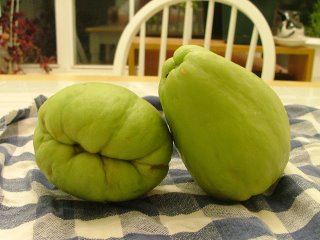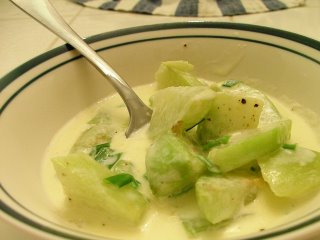 The chayote is a pear-shaped and -sized squash that goes by many names. My favorite is the one used in the French Caribbean islands: christophene. Oddly, the Larousse Gastronomique uses the English term "custard marrow", akin to the use of the word marrow when referring to a large zucchini.
The chayote is a pear-shaped and -sized squash that goes by many names. My favorite is the one used in the French Caribbean islands: christophene. Oddly, the Larousse Gastronomique uses the English term "custard marrow", akin to the use of the word marrow when referring to a large zucchini. Back in 2003, I was on a major squash kick. I'd had yellow summer squash, cucumbers, and zucchini before, but had somehow skipped the various winter squash. Except for pumpkin, but those are generally used around here in the canned variety or as simple decoration in the fall. I went through acorn and butternut and turban squash, as well as a few unnamed hybrids that would show up from time to time at the farmer's market.
 For the preparation of the chayotes, I found a recipe that suggested softening them in hot oil and then cooking with some cream for a bit, followed by a topping of sliced green onions. Most chayote recipes seemed to use them just for bulk, and I wanted to really focus on the flavor of the squash. I'd heard it referred to as "mild" before, but it's pretty flavorless. In general, I'd compare it to a cross between a cucumber and a honeydew melon, yet watered down. It's clean and crisp, and ever-so-slightly sweet, but more confusing than anything else.
For the preparation of the chayotes, I found a recipe that suggested softening them in hot oil and then cooking with some cream for a bit, followed by a topping of sliced green onions. Most chayote recipes seemed to use them just for bulk, and I wanted to really focus on the flavor of the squash. I'd heard it referred to as "mild" before, but it's pretty flavorless. In general, I'd compare it to a cross between a cucumber and a honeydew melon, yet watered down. It's clean and crisp, and ever-so-slightly sweet, but more confusing than anything else. Final verdict: I don't know if I'll be incorporating chayotes into any dishes in the future. Maybe some raw diced pieces in a salsa fresca over seafood. Maybe as a mystery ingredient in a salad. It doesn't taste bad, there's just not enough flavor there to make it a significant ingredient. They are, however, quite easy to peel with a standard vegetable peeler. The skin is only about as thick as that of an apple or potato, unlike the thicker rind of some squash varieties.

No comments:
Post a Comment